The common merganser (North American) or goosander (Eurasian) (Mergus merganser) is a large seaduck of rivers and lakes in forested areas of Europe, Asia, and North America. The common merganser eats mainly fish. It nests in holes in trees.
It is 58–72 cm (23–28+1⁄2 in) long with a 78–97 cm (30+1⁄2–38 in) wingspan and a weight of 0.9–2.1 kg (2 lb 0 oz – 4 lb 10 oz); males average slightly larger than females, but with some overlap.
Like other species in the genus Mergus, it has a crest of longer head feathers, but these usually lie smoothly rounded behind the head, not normally forming an erect crest. Adult males in breeding plumage are easily distinguished, the body white with a variable salmon-pink tinge, the head black with an iridescent green gloss, the rump and tail grey, and the wings largely white on the inner half, black on the outer half. Females and males in "eclipse" (non-breeding plumage, July to October) are largely grey, with a reddish-brown head, white chin, and white secondary feathers on the wing. Juveniles (both sexes) are similar to adult females but also show a short black-edged white stripe between the eye and bill. The bill and legs are red to brownish-red, brightest on adult males, dullest on juveniles.
Like the other mergansers, these piscivorous ducks have serrated edges to their bills to help them grip their prey, so they are often known as "sawbills". In addition to fish, they take a wide range of other aquatic prey, such as molluscs, crustaceans, worms, insect larvae, and amphibians; more rarely, small mammals and birds may be taken.[5][6] As in other birds with the character, the salmon-pink tinge shown variably by males is probably diet-related, obtained from the carotenoid pigments present in some crustaceans and fish.[8] When not diving for food, they are usually seen swimming on the water surface, or resting on rocks in midstream or hidden among riverbank vegetation, or (in winter) on the edge of floating ice.
In most places, the common merganser is as much a frequenter of salt water as fresh water. In larger streams and rivers, they float down with the stream for a few miles, and either fly back again or more commonly fish their way back, diving incessantly the whole way. In smaller streams, they are present in pairs or smaller groups, and they float down, twisting round and round in the rapids, or fishing vigorously in a deep pool near the foot of a waterfall or rapid. When floating leisurely, they position themselves in water similar to ducks, but they also swim deep in water like cormorants, especially when swimming upstream. They often sit on a rock in the middle of the water, similar to cormorants, often half-opening their wings to the sun. To rise from water, they flap along the surface for many yards. Once they are airborne, their flight is strong and rapid. They often fish in a group forming a semicircle and driving the fish into shallow water, where they are captured easily. Their ordinary voice is a low, harsh croak, but during the breeding season, males in display, as well as young, make a plaintive, soft whistle. Generally, they are wary, and one or more birds stay on sentry duty to warn the flock of approaching danger. When disturbed, they often disgorge food before moving. Though they move clumsily on land, they resort to running when pressed, assuming a very upright position similar to penguins, and falling and stumbling frequently.
Breeding
Nesting is normally in a tree cavity, so it requires mature forest as its breeding habitat; they also readily use large nest boxes where provided, requiring an entrance hole 15 cm (6 in) in diameter. In places devoid of trees (like Central Asian mountains), they use holes in cliffs and steep, high banks, sometimes at considerable distances from the water. The female lays 6–17 (most often 8–12) white to yellowish eggs, and raises one brood in a season. The ducklings are taken by their mother in her bill to rivers or lakes immediately after hatching, where they feed on freshwater invertebrates and small fish fry, fledging when 60–70 days old. The young are sexually mature at the age of two years. Common mergansers are known to form crèches, with single females having been observed with over 70 ducklings at one time.
Movements
The species is a partial migrant, with birds moving away from areas where rivers and major lakes freeze in the winter, but resident where waters remain open. Eastern North American birds move south in small groups to the United States wherever ice-free conditions exist on lakes and rivers; on the milder Pacific coast, they are permanent residents. Scandinavian and Russian birds also migrate southwards, but western European birds, and a few in Japan, are largely resident.[5][6] In some populations, the males also show distinct moult migration, leaving the breeding areas as soon as the young hatch to spend the summer (June to September) elsewhere. Notably, most of the western European male population migrates north to estuaries in Finnmark in northern Norway (principally Tanafjord) to moult, leaving the females to care for the ducklings. Much smaller numbers of males also use estuaries in eastern Scotland as a moulting area.
Source: Wikipedia
Morčák velký (Mergus merganser) je velký vrubozobý pták z čeledi kachnovití s rozsáhlým areálem rozšíření. Hojně se vyskytuje na velkém území Evropy, Asie a Severní Ameriky.
Délka těla: 58–80 cm
Rozpětí křídel: 100 cm
Hmotnost: 1100–2000 g
Morčák velký je o něco větší než kachna divoká. Má dlouhé tělo, velkou hlavu a tenký, na konci zahnutý zobák s pilovitými okraji pro lepší uchopení kořisti.
Ve svatebním šatě má samec lesklou, tmavě zelenou hlavu, šedozelený hřbet, sněhově bílé boky a červené končetiny a zobák.
Samice není zdaleka tak výrazně zbarvena, ale i přesto působí půvabným dojmem hlavně díky odstávajícím perům v týle, která nejsou u samce tak nápadná. Je celá šedá s hnědou hlavou a stejně jako samec má červený zobák a končetiny. Po zbytek roku jsou obě pohlaví zbarvena stejně.
Morčáka velkého nalezneme na jezerech a pomalu tekoucích řekách, velice často bývá chován jako okrasný pták v parkových jezírkách. Je částečně tažný, jedinci ze severoevropských oblastí na zimu migrují do střední a jižní Evropy, kde se zdržují od listopadu do března.
Mimo období rozmnožování se nijak neozývá, tokající samec však vydává hluboké „kerr kerr“.
Morčák je skvěle přizpůsoben k lovu ryb, dokáže poměrně rychle plavat i v 3metrových hloubkách a k jejich lepšímu uchopení má skvěle přizpůsobený zobák (viz popis). Jeho potravou se občas stávají i jiní vodní živočichové, nejčastěji měkkýši, korýši nebo slávky; pro mláďata je hlavní složkou potravy vodní hmyz.
Hnízdí od dubna do května a nejčastěji zahnizďuje v dutinách stromů, pod loděnicemi, na skalách nebo ve velkých dřevěných budkách. Ročně klade 6 až 17 vajec, na kterých sedí po dobu 30 – 35 dní. Mláďata se plně osamostatňují ve věku 60–70 dní.
Zdroj: Wikipedia
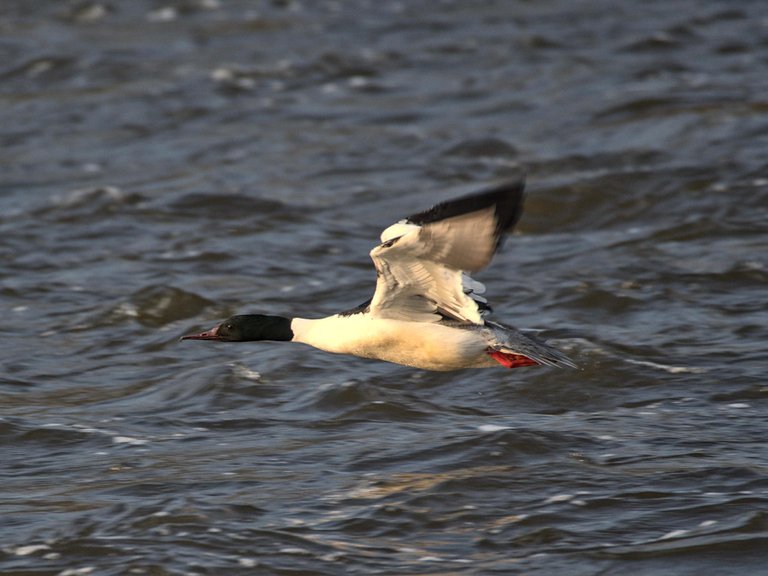
This species is increasing in the Czech Republic, nesting and wintering on rivers and larger reservoirs.
V Česku tento druh přibývá, hnízdí tu i přezimuje na řekách větších vodních nádržích.
On the steep, shallow flow of the Vltava above the Prague Zoo they are regularly. Not only do they swim there, but they like to sit on the large rocks that protrude from the river.
Na prudkém, mělkém toku Vltavy nad pražskou ZOO jsou pravidelně.
Nejenže tam plavou a loví, ale rádi posedávají na velkých kamenech, které vyčnívají z řeky.
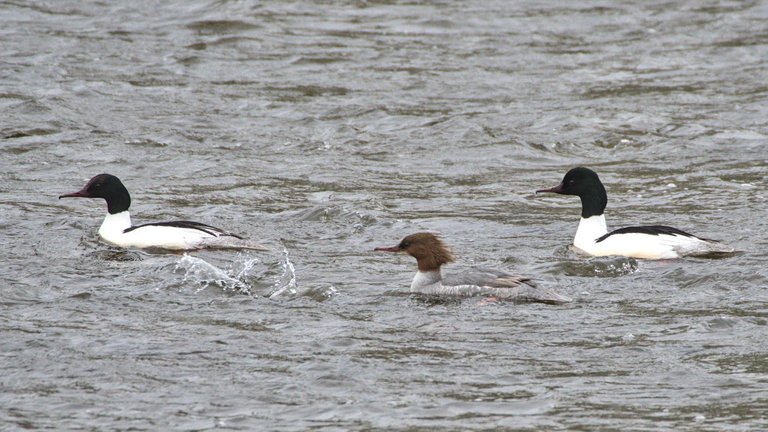
https://www.inaturalist.org/observations/80913929
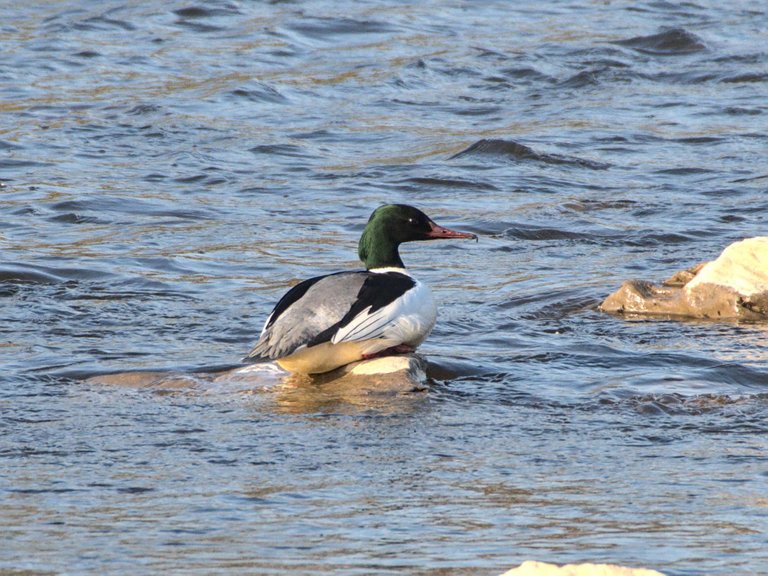
https://www.inaturalist.org/observations/80910610
Berounka, you can see them standing in the shallows.
Berounka, je vidět, jak postávají na mělčině.
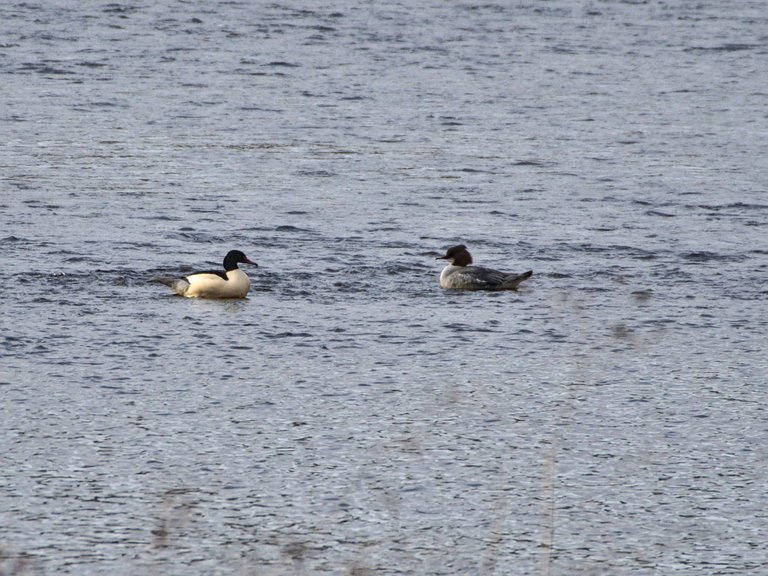
https://www.inaturalist.org/observations/69446658
They usually fly over the Berounka and as the river is narrower, you can take a photo "from hand".
Nad Berounkou běžně přeletují a jak je řeka užší, tak se dá udělat foto i "z ruky".
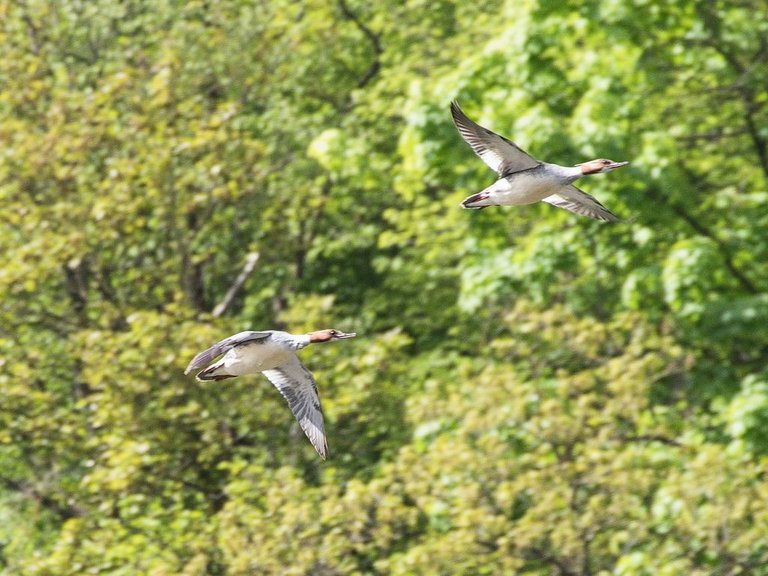
https://www.inaturalist.org/observations/45358796
Here they are on the Vlkava stream in the middle of meadows, a kind of wetland terrain.
It's not far from the Elbe, but it surprised me. I mainly photographed insects around the creek and then spotted them.
You can see them looking "over their shoulder" at me.
I guess there's fish there and something to eat.
Tady jsou na potoce Vlkava uprostřed luk, takový mokřadní terén.
Sice je to nedaleko Labe, ale dost mě to překvapilo.
Fotil jsem hlavně hmyz kolem potoka a pak je zahlédl a hledal si místo s výhledem přes rákosí.
Je vidět, jak se na mě dívají "přes rameno". Asi jsou tam ryby a je co žrát.
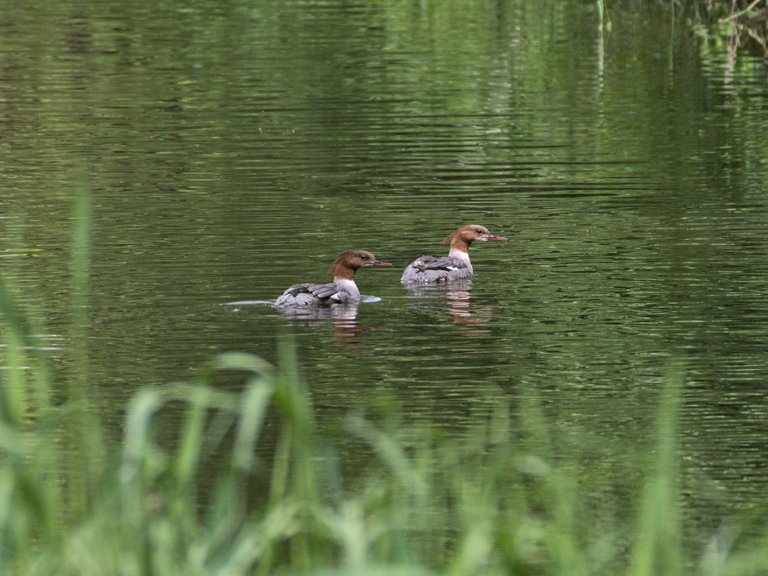
https://www.inaturalist.org/observations/83825388
North Bohemia, water reservoir Újezd on the river Bílina. In December there were a hundred of them.
Severní Čechy, vodní nádrž Újezd na řece Bílině. V prosinci jich tam byla stovka.

https://www.inaturalist.org/observations/36827790
November fog on the Nechranice dam on the Ohře river. You could hardly see.
Listopadová mlha na přehradě Nechranice na Ohři. Skoro nebylo vidět.

https://www.inaturalist.org/observations/144373471
Winter Elbe near Litoměřice, now a classic location. The river is wide and the birds always stay far away on the other bank or fly away.
Just too far for a 300m lens.
Zimní Labe u Litoměřic, dnes už klasická lokalita. Řeka je široká a ptáci se drží vždy daleko na druhém břehu nebo uletí.
Na 300m objektiv prostě daleko.

https://www.inaturalist.org/observations/70003612
From February visit to Gabčíkov near Bratislava. Among many other ducks there are also Goosanders.
Z únorové návštěvy na Gabčíkovu pod Bratislavou. Mezi spoustou jiných kachen jsou i Morčáci velcí.

https://www.inaturalist.org/observations/106732349
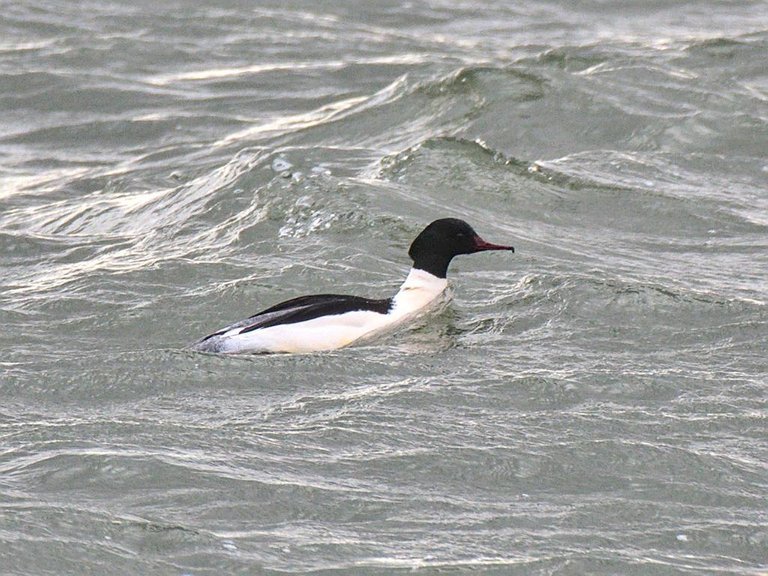
https://www.inaturalist.org/observations/106730745

